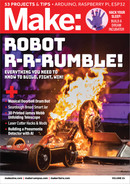
6. Once the mirror is in place, use the silicone
sealant to glue the 3" clear acrylic disk to the
bottom end of the clear acrylic tube (Figure
E
).
I tied mine on tight until the sealant dried.
7. Check the fit between the clear plastic tube
and the interior of the PVC tube. Apply a layer
or two of duct tape to the upper edge of the
clear tube if the fit is not tight.
Apply silicone adhesive/sealant to the upper
1" of the clear tube (or its duct tape) and then
insert it 3" deep into end of the PVC tube. I
also ran a bead of sealant all around the joint
(Figure
F
). Let the silicone cure according
to label directions. Before the sealant dries,
rotate the clear tube so the mirror points 180
degrees opposite the nose notch in the PVC
tube (or the angle of your choice).
8. Use the silicone to attach the waterproof light
to the side of the PVC tube so that it shines in
the direction that the mirror faces.
9. Let all the glue and sealant joints dry. With
your wrench, adjust the angle of the mirror to
45 degrees to look sideways.
10. Test the aquascope for leaks. If it leaks, apply
additional sealant, and check the fit of the
O-rings.
11. Stick the LED light to the side of the scope,
pointing the direction your mirror is looking.
USING THE AQUASCOPE
Like Mather’s original aquascope, this project
allows the user to make nighttime observations
and to look 90 degrees to the side of scope.
But it’s also adjustable so you can look in other
directions.
• To look 90 degrees to the side, keep the mirror
at a 45-degree angle.
• To look straight down, position the mirror
vertically, so you can see past it, straight
down through the clear bottom disc, and then
tighten the bolts.
• Whichever angle you look, you could add more
LED lights pointed in that direction.
95
make.co
C
E
F
D
M81_092-95_RemHist_F1.indd 95M81_092-95_RemHist_F1.indd 95 4/12/22 12:31 PM4/12/22 12:31 PM
..................Content has been hidden....................
You can't read the all page of ebook, please click here login for view all page.
